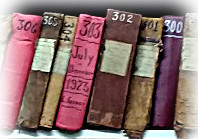
 |
Drifting temperature air conditioning |
This article and lecture (linked above) is a contribution to the colloquium on the evolution of preventive conservation in France. It is organised by APrevU (aprevu.com) and happens on 8 - 9 June 2017 in Paris. This article emphasises the constraints exercised by national and international standards for the museum environment. The lecture is quite different: comparing two archives with very similar storage climates, one fully air conditioned, the other uncontrolled but for a minimum allowed temperature at 15 degrees.
The climate within museum stores and archives can be regulated by dehumidifying a building whose temperature is allowed to vary seasonally without explicit control. The ground beneath the building provides thermal inertia to hold the annual temperature cycle around 8 – 16°C, in northern Europe. A well insulated above-ground structure moderates short term fluctuations in the weather. Good airtightness reduces the energy required for dehumidification. This combination of cool and dry storage is beneficial to the vast majority of artifacts. However, the implementation of such storage is inhibited by some restrictive standards for the museum and archive environment.
The acceptable environment for artifacts is imposed by museum environment standards, which set permitted temperature and relative humidity ranges, explicitly based on the perceived needs of the artifacts, but in reality based on the human need for warmth. In northern Europe, and many other parts of the world, the annual average ambient temperature is well below the temperature for human comfort. One can cynically remark that museum environment standards enforce accelerated ageing by demanding winter heating. This is defensible on the grounds that it is humans who have created the art, for each others’ enjoyment or enlightenment.
In a museum store or an archive, the demand for human comfort vanishes, or at least becomes subordinate to the effort to preserve the collection. For this purpose, a low temperature has long been shown to be an almost universal preservative, whose quantitative effectiveness is defined by the collision theory of chemical reaction, first formulated by Svante Arrhenius in 1889. A low relative humidity (RH) has also been asserted as chemically preservative. The often cited relationship between temperature, RH and degradation rate is that proposed by Don Sebera (Sebera 1994), who uses the Arrhenius equation for the temperature sensitivity of reaction rate and the law of mass action to make the degradation rate proportional to RH. However, there is no doubt that the potency of RH in degradation reactions is not so simply described as Sebera’s smooth curves suggest. A recent paper by Kočar et al (Kočar et al. 2005) shows the very different susceptibility of alkaline and acid papers to high RH. It seems that a low RH is, for some materials, much more preservative than proportionality predicts. A likely reason is that at high RH an aqueous phase forms from traces of deliquescent materials and provides an ionising environment for degradative reactions. This has been shown by Tennent and Baird (Tennent and Baird 1985) for the decay of carbonate shells exposed to acetic acid vapour.
The simplest way to provide a cool store is not to heat it. Figure 1 shows the likely course of the temperature in an unheated large space in a northern European city (in this case Brussels). How this curve is achieved is explained later, with an actual built example. Note that the temperature curve average value is above the annual average ambient temperature. This is because of sources of heat in the building: people and lights and computers. For now we concentrate on the consequent RH variation.
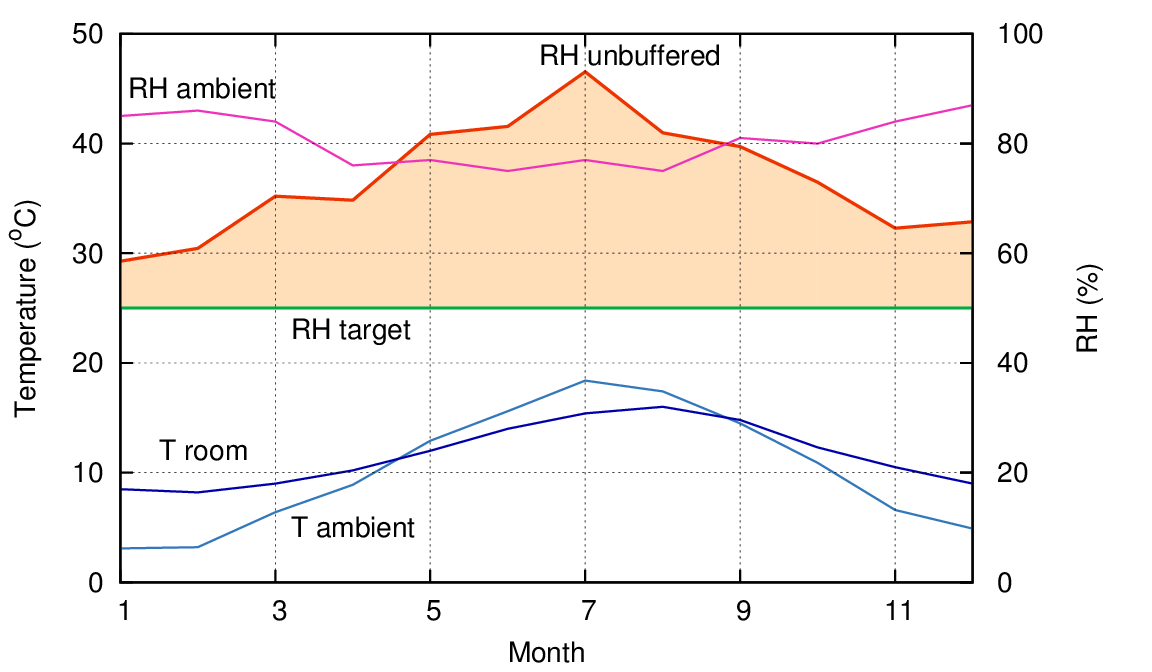
Figure 1: The anticipated temperature through the year in an unheated store in northern Europe, and the consequent high indoor RH, assuming good ventilation and negligible humidity buffering. The shaded area indicates that dehumidification is needed year round, and humidification never.
The RH will be above the range 40% to 60% which is accepted as reasonable for museum storage. To achieve a moderate RH without dehumidification, the temperature must be raised considerably. This is called Conservation Heating and is used to moderate the RH in historic houses and museums which are closed in winter, when human-friendly warmth is not required. Conservation heating is a reasonable intervention in leaky historic structures, because it will maintain the desired RH regardless of the air exchange rate. The energy cost will change, but not the climatic effectiveness. In a purpose-built store, modern building methods can ensure a very low air exchange rate as well as a low heat exchange with the ambient air. Dehumidification becomes a feasible alternative, particularly in windowless rooms with only one entrance and an emergency exit.
The simplest way to achieve a temperature which follows the ambient temperature but with much reduced annual span is to provide a large thermal mass. This is readily available in the ground beneath the building. It is usual nowadays to insulate beneath buildings, but this is only beneficial in buildings which are nearly always kept above ambient temperature for the comfort of the human occupants. For a museum store there is a thermal advantage in spreading the building as a relatively low structure over a large area of ground which, over a period of a few years, becomes part of the building’s thermal properties. This is shown in figure 2. An important feature to note is that the floor beneath the building has a small vertical temperature gradient, compared with that outside. Heat flow is proportional to the temperature gradient, so the heat flow between the building and the soil at depth is very small. Low, spreading buildings have a large surface to volume ratio, so heat transfer through the above ground structure is large, per unit of volume. However, modern insulation gives a very low heat transmission (U-value) so the wide spread is no longer a disadvantage but helps with the movement of items in and out of storage. A single open space also gives good temperature uniformity within the space, as shown in figure 3.
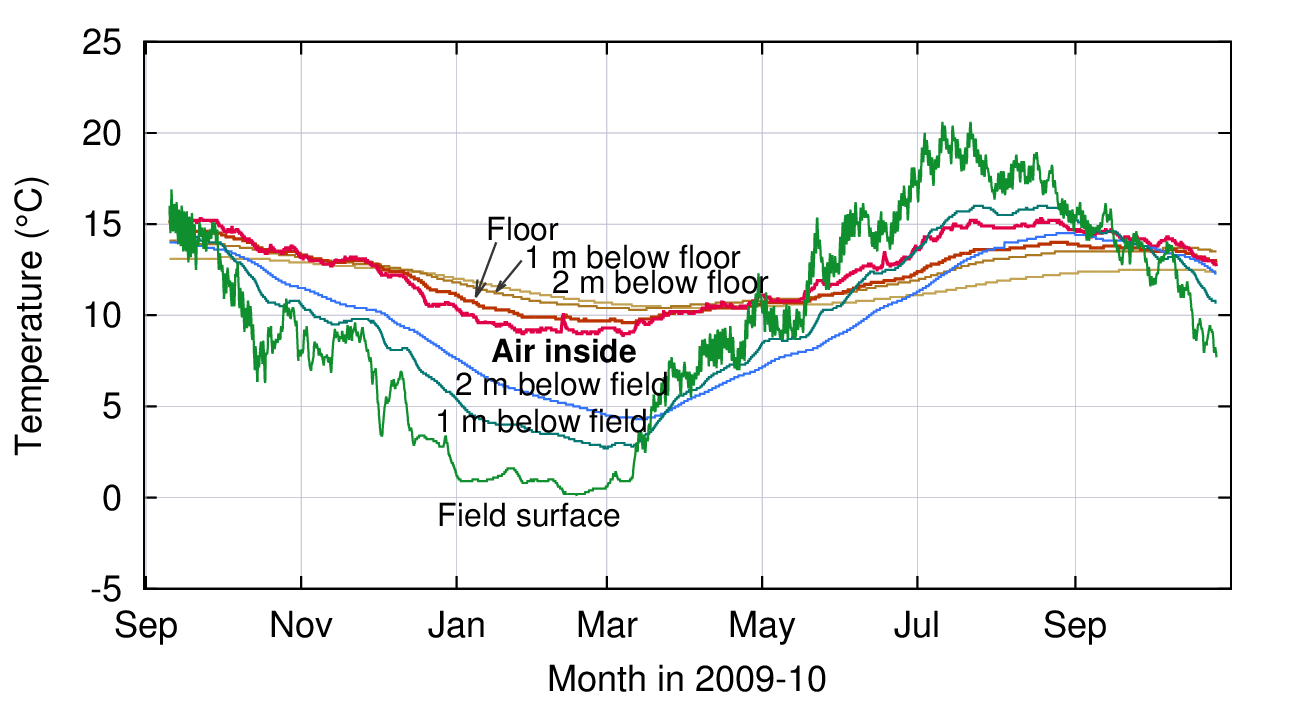
Figure 2: The temperature gradient in the uninsulated floor of the museum store in Ribe, Denmark.
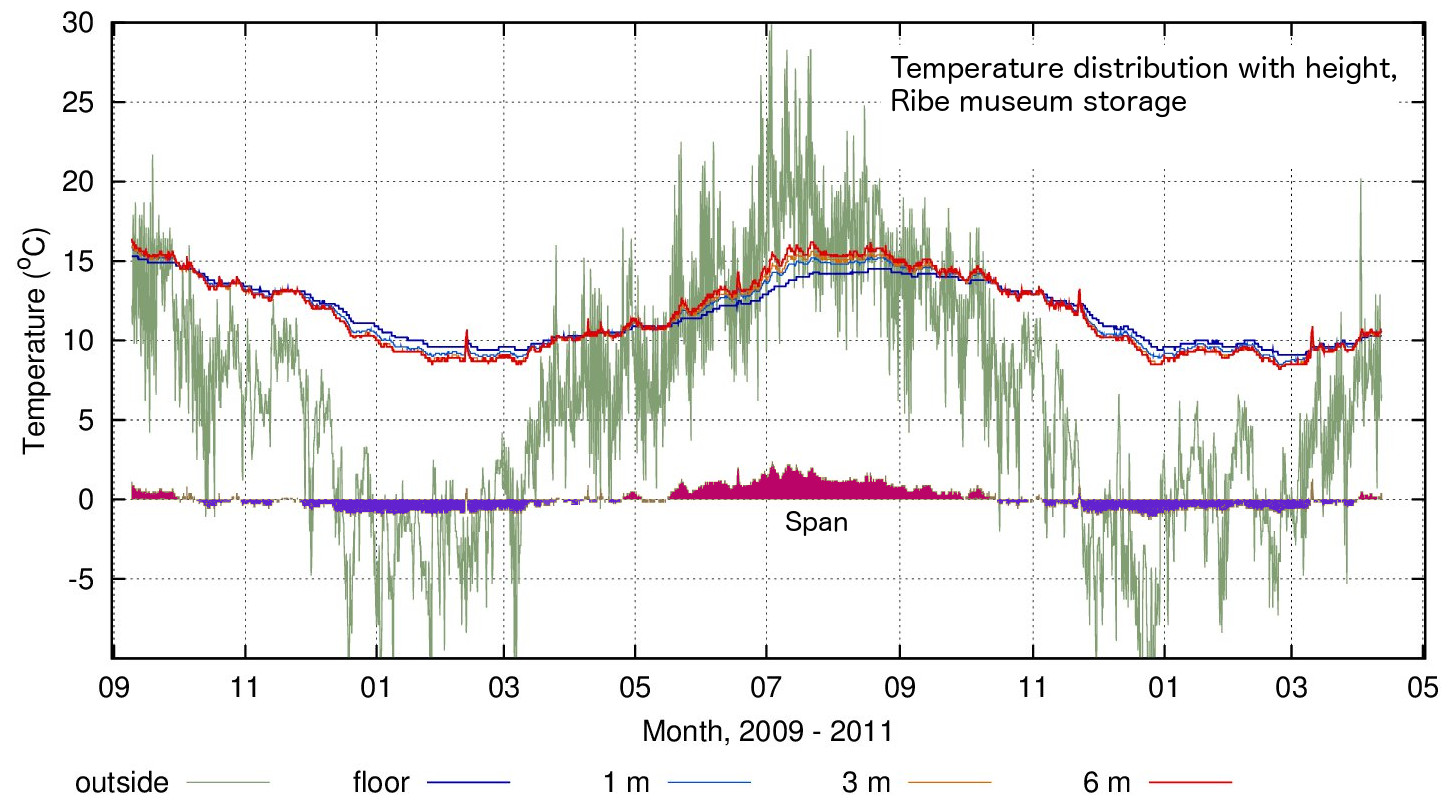
Figure 3: The temperature gradient within the museum store in Ribe.
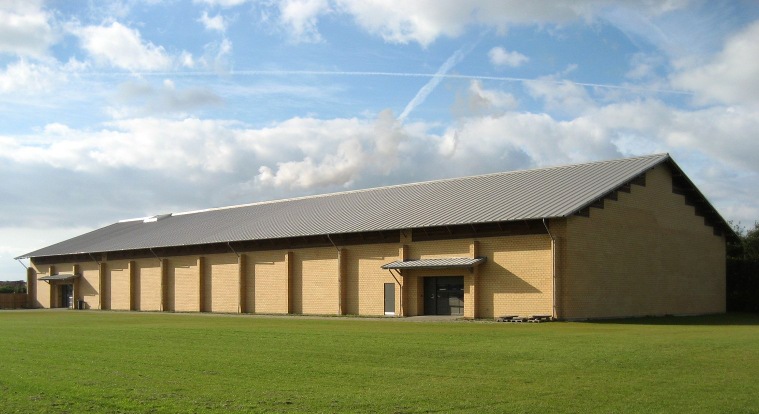
Figure 4: The museum store in Ribe.
The RH must be reduced by dehumidification. This is the only mechanical aid needed. In principle, dehumidification is needed all the year but in real museum stores winter dehumidification is hardly needed. There are two reasons for this.
The inside air is warmer in winter. In February, for example, the outside air in Brussels averages 3.2°C, with the RH at 86%. This air, brought to the 8°C of the room will have a RH at 62%, barely above the permitted upper limit.
Humidity buffering. All museum stores have a considerable quantity of hygroscopic materials, such as cardboard boxes. Archives have a very large humidity buffer capacity, which gives year round RH stability, so the archive ‘remembers’ the past summer’s dehumidified RH far into the winter. Conservators have remarked that it is unethical to use archived material to control its own environment. However, it does so anyway, by continually exchanging water molecules with the surrounding air, even at a constant RH. The buffer effect is demonstrated by data from the Suffolk Record Office, shown in figure 5. Although the RH was moderated in this case by heating to a constant temperature in winter, the RH stability over the summer is remarkable.
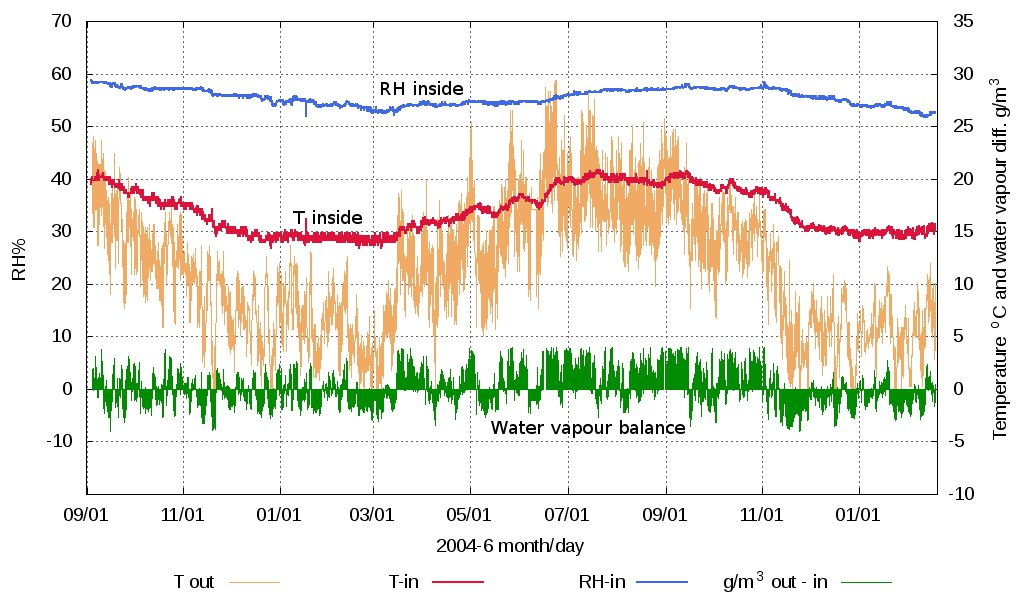
Figure 5: The climate within the Suffolk Record Office in Ipswich, UK. Humidity buffering by the archived material is shown by the disequilibrium between inside and outside water vapour concentration. (Data provided by Dominic Wall).
Even in a general purpose museum store, with limited buffer capacity, there is no need for winter control of the RH, only summer dehumidification is needed. Furthermore, the dehumidifier can be operated intermittently and can have barely the capacity needed, which is an advantage because it cannot do damage by operating constantly, and buffering ensures that the store does not attain a dangerously high RH when the dehumidifier doesn’t operate at all for a while. This makes the building well suited to using solar energy alone.
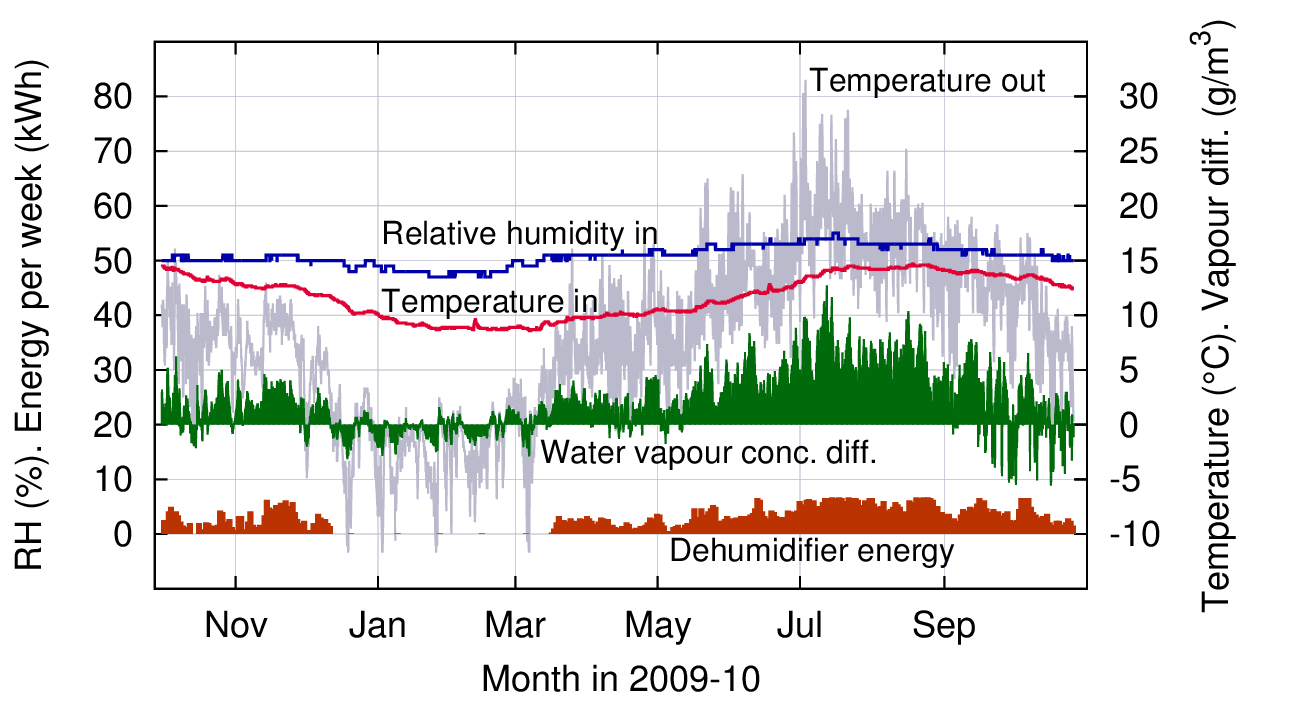
Figure 6: The climate within the Ribe museum store, showing the energy used for dehumidification, which peaks in July to August.
Figure 6 shows the performance of a museum store which functions as described in this article, with no explicit temperature control but with dehumidification to an arbitrarily set target value. This provides the best preservation climate which can be obtained with minimum use of energy, minimum complexity of equipment and minimum maintenance demand. The exact specification for this building is given in (Ryhl-Svendsen et al. 2012).
There is one serious hindrance to the implementation of this simple, energy efficient and preservative design for museum and archive storage. Some standards set a relatively high minimum temperature which demands winter heating. The British Standards Institution advisory document PD5454 (BSI 2012) sets a minimum temperature for valuable collections at 13°C, mainly because of the risk of efflorescence on pure beeswax seals. The limit is based on a single published paper (Novotná and Dernovšková 2002) about the separation of phases in pure, new beeswax seals. One could argue that pure beeswax seals which have never been exposed to low temperature must be very rare, since admixture with resin, pigments and later with shellac became widespread from the Middle Ages. However, archives contain far more poor quality paper from the last two centuries which definitely benefits from cool storage. One must question the risk analysis done by the anonymous committee, which has transferred this same limit into the current draft of its new standard for archives.
Other standards are more relaxed and respect the beneficial effect of low temperature. ISO 11799 (ISO 2003) gives the preservative quality of various temperature ranges: “16–23 fair; 8–16 good; 0–8 very good; minus 20–0 Necessary for some materials.”
There is now abundant evidence from existing museum storage and archive buildings that preservation in an unheated building is effective, cheap and simple. It requires only dehumidification to control the climate for good preservation. The physics is clear; the building techniques are available; the advice from prestigious standards committees inhibits the realisation of such buildings.
Donald K Sebera. Isoperms: An environmental management tool. 1994. URL http://cool.conservation-us.org/byauth/sebera/isoperm/.
Drago Kočar, Matija Strlič, Jana Kolar, Jozef Rychlỳ, Lyda Matisová-Rychlá, and Boris Pihlar. Chemiluminescence from paper iii: the effect of superoxide anion and water. Polymer degradation and stability, 88 (3):407–414, 2005.
Norman H Tennent and Thomas Baird. The deterioration of mollusca collections: identification of shell efflorescence. Studies in Conservation, 30 (2):73–85, 1985.
Morten Ryhl-Svendsen, Lars Aasbjerg Jensen, Benny Bøhm, and Poul Klenz Larsen. Low energy museum storage buildings: climate, energy consumption and air quality. Technical report, National Museum of Denmark, 2012.
BSI. PD5454:2012 guide for the storage and exhibition of archival materials. Technical report, British Standards Institution, 2012.
P Novotná and J Dernovšková. Surface crystallisation on beeswax seals. Restaurator, 23(4):256–269, 2002.
ISO 11799 information and documentation – document storage requirements for archive and library materials. Technical report, International Standards Institution, 2003.
Copyright, the authors, 2017

This work is licensed under a Creative Commons Attribution-Noncommercial-No Derivative Works 3.0 License.